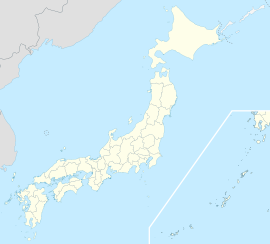 | |
| Local date | May 8, 1847 |
|---|---|
| Local time | 21:30 |
| Magnitude | 7.4 Ms |
| Epicenter | 36°42′N 138°12′E / 36.7°N 138.2°E [1] |
| Casualties | ≥ 8,600 |
The 1847 Zenkoji earthquake (善光寺地震, Zenkōji jishin) occurred at about 21:30 local time on 8 May at Nagano, Japan. It had a magnitude of 7.4 on the surface wave magnitude scale. It caused the destruction of many houses in Nagano and at least 8,600 people were killed. The earthquake triggered many landslides, the largest of which dammed the Sai River (a tributary of the Shinano River). 19 days later, the failure of this earthquake dam caused a flood that destroyed many more houses and killed 35 people. [2]
Tectonic setting
During the middle of the Miocene period Japan was affected by the opening of the Sea of Japan as a back-arc basin in response to continuing subduction of the Pacific Plate. This period of extensional tectonics caused the development of rift basins on the western side of Honshu, including the northern part of the Fossa Magna. When the back-arc spreading stopped during the late Miocene, the rifted area started to shorten and the basins became inverted. [3] The western margin of the Nagano Basin, part of the Fossa Magna, is formed by an active reverse fault zone, the West Nagano Basin Fault. The 1847 earthquake was caused by rupture on part of this fault zone. [4]
Landslides
The earthquake triggered a large number of landslides, due mainly the relatively unconsolidated Miocene sediments. At least seven of these formed dams on rivers in the surrounding area. The largest of these dams was formed at the foot of Mount Iwakura from a landslide with an estimated volume of 20 million cubic metres that blocked the Sai River. The water held back by the dam eventually broke through 19 days after the earthquake, flooding a large area downstream from the dam. [5]
References
- ^ 善光寺地震 - Kotobank
- ^ National Geophysical Data Center / World Data Service (NGDC/WDS): NCEI/WDS Global Significant Earthquake Database. NOAA National Centers for Environmental Information (1972). "Significant Earthquake Information". NOAA National Centers for Environmental Information. doi: 10.7289/V5TD9V7K. Retrieved 30 July 2022.
- ^ Sato H.; Iwasaki T.; Kawasaki S.; Ikeda Y.; Matsuta N.; Takeda T.; Hirata N.; Kawanaka T> (2004). "Formation and shortening deformation of a back-arc rift basin revealed by deep seismic profiling, central Japan". Tectonophysics. 388 (1–4): 47–58. Bibcode: 2004Tectp.388...47S. doi: 10.1016/j.tecto.2004.07.004.
- ^ Sugito N.; Okada A.; Tsutsumi H. (2010). "Geologic Evidence for Surface Rupture Associated with the 1847 M 7.4 Zenkoji Earthquake at Dannohara, Nagano City, Japan". Bulletin of the Seismological Society of America. 100 (4): 1678–1694. Bibcode: 2010BuSSA.100.1678S. doi: 10.1785/0120090171.
- ^ Inoue K.; Mori T.; Mizuyama T. (2012). "Three Large Historical Landslide Dams and Outburst Disasters in the North Fossa Magna Area, Central Japan". International Journal of Erosion Control Engineering. 5 (2): 134–143. doi: 10.13101/ijece.5.134.


